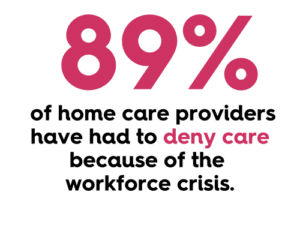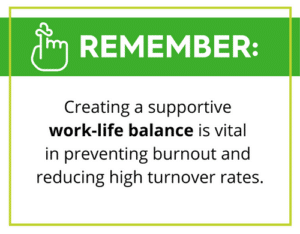As the demand for home-based care accelerates – ongoing staffing shortages are not just a challenge for agencies – it’s putting patients’ quality of care at risk.
According to The State of America’s Direct Support Workforce Crisis 2023 report, “about 95% of providers indicated moderate or severe staffing shortages over the past year, while 77% turned away new referrals due to those staffing shortages.”
In this blog, we cover the different sides of the staffing issue and its effect on:
- Post-acute care organizations
- Caregivers
- Patients
From the headwinds contributing to the staffing shortages to practical strategies the post-acute care industry can start to implement – our goal isn’t just to talk about the shortage but to highlight practical solutions.
Key Challenges Affecting the Staffing Shortage
Looking at the past year and the early months of 2024, a perfect storm of headwinds has emerged – contributing to the staffing shortage crisis in the post-acute care industry.
Let’s break down each headwind from workforce shortages to a demanding work environment.
Workforce Shortages
Did you know?
According to the Value-Based Payment (VBP) blog, “While the direct care worker workforce, which includes personal care aides, certified nursing assistants, home health aides, residential care aides, psychiatric aides, and other occupations, has more than doubled from 2000, supply is still expected to fall short of demand.”
The U.S. Bureau of Labor Statistics (BLS) projections “estimate that by 2031, there will be a million new home health and personal care aide jobs, and we are going to fall short of filling these positions.”
As organizations navigate the misalignment between a shortage of caregivers and the growing need for home-based care, they need to address the necessity of a strategic approach the industry needs to take that includes innovative strategies to recruit and retain top caregivers.
This shortage threatens not only the operational capacity of organizations but also the quality and accessibility of home-based care for those who need it most.
Aging Population
As mentioned above – the rapidly aging population is driving a significant increase in the demand for home-based care, and at this rate, we will create a million new jobs by 2031.
However, the aging population isn’t slowing down soon, thus emphasizing the urgency for a strategic and proactive approach to attracting and retaining qualified caregivers in a competitive field.
Therefore, the industry must create a forward-thinking strategy that not only looks ahead to the future of caregiver needs but also brings quality care to home-based care patients.
Low wages and benefits
Another headwind factor is low wages and benefits.
In a recent survey conducted by Homecare Homebase – 38% of participants said wage pressure was a big concern for 2024.
The post-acute care industry is not only struggling with the financial strain of this headwind but also with the potential concern of loyalty and dedication of caregivers.
Demanding work environment
The third headwind is a demanding work environment.
Once caregivers are hired at a post-acute care organization, they can experience a challenging workload – especially when they are in the field and traveling from home to home, taking care of patients all day.
However, if the workload becomes too demanding, it can end up causing severe burnout among caregivers to the point of them not caring or quitting altogether.
Thus resulting in low retention and high turnover rates due to the caregivers believing the organization isn’t supporting them.
Unraveling the Impact of the Staffing Shortage

Agencies
Unfortunately, increasing demand for post-acute care has outpaced the availability of both organizations and caregivers – presenting a challenge for the sales teams.
The issue lies in the delicate balance between acquiring new referrals and the actual capacity of caregivers to manage the increasing workload.
According to the Value Based Payment (VBP) blog, “89% of home care providers have had to deny care because of the workforce crisis. On average, small to mid-sized providers refuse 510 care hours each month.”
Caregivers who already have a full schedule may find it challenging to provide new patients with the essential care they require, and in some cases, they may even have to turn away these patients.
Consequently, organizations may lose revenue or earn a bad reputation by taking on new referrals only for them to be turned away.
Caregivers
As briefly mentioned above, as new referrals come in daily for organizations – they can impact caregivers.
When organizations are understaffed, this can elevate the risk of costly errors, ranging from missed appointments to forgotten check-ins and prescription refills, potentially compromising patient safety and well-being.
These errors strain the trust between caregivers and patients, thus contributing to increased work pressure and dissatisfaction and ultimately resulting in valuable caregivers quitting.
Addressing the staffing challenge is not only critical for ensuring the welfare of caregivers but is also important to maintaining the quality and reliability of home care-based services.
Patients
While it’s essential to cover the severity of the staffing shortage for organizations – it’s also critical to consider how post-acute care patients are affected.
According to a recent article from Home Healthcare News, “72% of respondents reported difficulty adhering to quality standards due to those staffing woes.”
With fewer caregivers available – patients may experience longer response times, less personalized care, and an overall diminished experience, leading to decreased satisfaction with post-acute care organizations.
This sets off a downward spiral for patients and their families, eroding trust and increasing the emotional toll on patients during their vulnerable moments.
Finding a solution to staffing challenges becomes essential to organizations, and it is a moral obligation to ensure every home-based care patient receives the care they need.
Innovative Solutions to Post-Acute Care Staffing Challenge
Below are a few strategies organizations can implement to tackle the challenges discussed earlier proactively.
These strategies aim to ease immediate pressure on caregivers, foster a resilient workforce, and enhance patient care quality.
Increased wages and benefits
The most significant solution to help decrease the severity of the staffing shortage is increasing wages and benefits for caregivers.
By increasing wages and improving benefits, the industry can foster a work environment that values and appreciates caregivers and motivates them to provide consistent, high-quality care to patients.
When organizations provide competitive wages and benefits, they attract top talent and cultivate a culture of dedication and excellence, ultimately benefiting caregivers and patients receiving post-acute care services.
Investing in workforce development
Investing in workforce development emerges as another solution to helping caregivers feel supported and mitigate burnout in the post-acute care industry.
By offering continuing education courses, training programs, and growth opportunities – organizations empower their caregivers to grow in their careers and achieve success.
This approach enhances the caregivers’ skill sets and creates a supportive culture of continuous education.
In addition, organizations are investing in the well-being of their caregivers and cultivating an empowered workforce that positively impacts patient care.
Leveraging technology
Equipping caregivers with the right tools in the field streamlines workflows and elevates the quality of care they deliver.
By implementing an industry-specific integrated platform – caregivers can easily automate processes such as scheduling patients, documenting notes, and reporting, allocating more time to delivering quality patient care.
Therefore, leveraging the right tools to aid caregivers enables them to be efficient in the field and contributes to a higher standard of patient care.
Improving the work environment
Creating a supportive work-life balance involves listening to caregivers’ needs, ensuring they feel valued, and having the chance to relax and recuperate.
Achieving this balance is vital in preventing burnout and reducing high turnover rates. Still, more importantly – it creates a company culture that wholeheartedly values and supports the dedicated caregivers who deliver essential care to patients every day.
A Call for Collective Action
As we navigate the multifaceted challenges within the staffing shortage in the post-acute care industry – it becomes clear that the impact of this shortage affects not just agencies but also caregivers and patients.
Through strategies such as increased wages and benefits, investing in continuous education, leveraging technology, and improving work environments, there appears to be a path toward ensuring caregivers feel appreciated and fulfilled while providing quality patient care.














